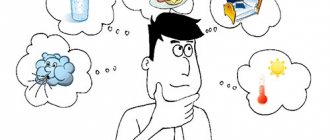Human needs are conditional, mobile, and virtual in nature. The virtuality of needs is that each of them contains its own other, a moment of self-negation. Due to the variety of conditions of implementation, age, environment, biological need becomes material, social or spiritual, i.e. transforms. In the parallelogram of needs (biological need - material - social - spiritual), the dominant need becomes the one that most corresponds to the personal meaning of a person’s life, is better equipped with the means of its satisfaction, i.e. the one who is better motivated.
The transition from need to activity is the process of changing the direction of need from within to the external environment. At the heart of any activity is a motive that encourages a person to do it, but not every activity can satisfy the motive. The mechanism of this transition includes: I) selection and motivation of the subject of need (motivation - justification of the subject to satisfy the need); 2) during the transition from need to activity, the need is transformed into purpose and interest (conscious need).
Thus, need and motivation are closely related: need stimulates a person to activity, and a component of activity is always motive.
Motive of man and personality
A motive is what motivates a person to act, directing him to satisfy a specific need. Motive is a reflection of need, which acts as an objective law, an objective necessity.
For example, the motive can be both hard work with inspiration and enthusiasm, and avoidance as a sign of protest.
Motives can be needs, thoughts, feelings and other mental formations. However, internal motivation is not enough to carry out activities. It is necessary to have an object of activity and correlate the motives with the goals that the individual wants to achieve as a result of the activity. In the motivational-target sphere, the social conditioning of activity appears with particular clarity.
By [[Motivational-need sphere of personality|need-motivational sphere of personality is meant the entire set of motives that are formed and develop during a person’s life. In general, this sphere is dynamic, but some motives are relatively stable and, subordinating other motives, form, as it were, the core of the entire sphere. These motives reveal the direction of the individual.
Motivation of a person and personality
Motivation is a set of internal and external driving forces that motivate a person to act in a specific, goal-directed manner; the process of motivating oneself and others to act to achieve organizational or personal goals.
The concept of “motivation” is broader than the concept of “motive”. Motive, in contrast to motivation, is something that belongs to the subject of behavior, is his stable personal property, which internally encourages him to perform certain actions. The concept of “motivation” has a double meaning: firstly, it is a system of factors influencing human behavior (needs, motives, goals, intentions, etc.), secondly, it is a characteristic of the process that stimulates and supports behavioral activity at a certain level. level.
In the motivational sphere, the following are distinguished:
- motivational system of a person is a general (holistic) organization of all the motivating forces of activity underlying human behavior, which includes such components as needs, actual motives, interests, drives, beliefs, goals, attitudes, stereotypes, norms, values, etc. .;
- achievement motivation - the need to achieve high behavioral results and satisfy all other needs;
- self-actualization motivation is the highest level in the hierarchy of personal motives, consisting of the individual’s need for the fullest realization of his potential, the need for self-realization.
Worthy goals, long-term plans, good organization will be ineffective if the interest of the performers in their implementation is not ensured, i.e. motivation. Motivation can compensate for many deficiencies in other functions, such as deficiencies in planning, but weak motivation is almost impossible to compensate for with anything.
Success in any activity depends not only on abilities and knowledge, but also on motivation (the desire to work and achieve high results). The higher the level of motivation and activity, the more factors (i.e. motives) prompt a person to activity, the more effort he is inclined to put in.
Highly motivated individuals work harder and tend to achieve better results in their activities. Motivation is one of the most important factors (along with abilities, knowledge, skills) that ensures success in activity.
It would be wrong to consider the motivational sphere of an individual only as a reflection of the totality of his own individual needs. The needs of the individual are related to the needs of society and are formed and developed in the context of their development. Some needs of an individual can be considered as individualized social needs. In the motivational sphere of a person, both his individual and social needs are reflected in one way or another. The form of reflection depends on the position the individual occupies in the system of social relations.
Motivation
Motivation is the process of influencing a person in order to encourage him to take certain actions by activating certain motives.
There are two main types of motivation:
- external influence on a person with the aim of inducing him to perform certain actions leading to a desired result. This type resembles a trade deal: “I give you what you want, and you satisfy my desire”;
- the formation of a certain motivational structure of a person as a type of motivation is educational in nature. Its implementation requires great effort, knowledge, and abilities, but the results exceed those of the first type of motivation.
Understanding
Motivation is the desire of any individual to carry out any actions or plans. It most often comes from the subject himself, but it can also arise as a result of the interaction of processes occurring independently of the person himself.
In other words, an incentive is a force that pushes an individual to perform some action, but leaves him the opportunity to choose. This phenomenon is a variant of positive desire, which distinguishes it from other types of motivation. The opposite term in meaning is the word “coercion”. The main synonyms of the word are motives, intentions, reasons, actions, etc.
System of human motives
Man is always driven by motives. Moreover, each person has many motives, which creates a certain system. Its development is first carried out by parents, and then by society, forming in the head of each individual certain beliefs and attitudes that will indicate the direction in which he will go.
Also, the direction of a person’s motives and movement through life is influenced by:
- Attractions are a human need that he may not be aware of. However, he feels the need to satisfy her (and perhaps she will disappear after that).
- An ideal is a certain picture of how it should be (what a person should be, how he should live and what he should do in a specific situation). This influences the fact that a person constantly wants to correspond to this ideal picture.
- Desires are drives that a person is aware of and become conscious goals to achieve. The individual himself begins to want them and strive to obtain them.
- Interest is increased attention to certain objects of the surrounding world, which influences the formation of desires.
- Aspirations – interest + willpower + conscious performance of actions to obtain a certain benefit.
- Addiction.
- Worldview and beliefs. This implies a holistic view of the world, as a person sees it, which determines in which direction he will go. Beliefs are certain views that are inviolable and true in a person’s head.
Interpretation
What is motivation? The term comes from the verb “to induce.” At first, the term denoted an action aimed at implementing any plans. Currently, the interpretation of the word has changed. There are several basic meanings of the term in the dictionary:
- an action close to the verb “to induce”;
- desire or intention to do something;
- attraction or desire to accomplish something.
The use of a word is related to its lexical meaning. Currently, the term “drive” is widely used in applied psychology. Some phrases in which the word is used have become common nouns (not for friendly reasons, don't trust sudden impulses, with the best of intentions, etc.).
Personal motives
Personal motives are the need (or system of needs) of the individual for the function of motivation. Internal mental motivations for activity and behavior are determined by the actualization of certain needs of the individual. Activity motives can be very different:
- organic - aimed at satisfying the natural needs of the body and are associated with the growth, self-preservation and development of the body;
- functional - satisfied through various cultural forms of activity, for example playing sports;
- material - encourage a person to engage in activities aimed at creating household items, various things and tools;
- social - give rise to various types of activities aimed at taking a certain place in society, gaining recognition and respect;
- spiritual - they form the basis of those activities that are associated with human self-improvement.
Organic and functional motives together constitute the motivation for the behavior and activity of an individual in certain circumstances and can not only influence, but change each other.
Human needs manifest themselves in specific forms. People may perceive their needs differently. Depending on this, motives are divided into emotional ones - desires, desires, attractions, etc. and rational - aspirations, interests, ideals, beliefs.
There are two groups of interconnected motives of life, behavior and activity of an individual:
- generalized, the content of which expresses the subject of needs and, accordingly, the direction of the individual’s aspirations. The strength of this motive is determined by the significance for a person of the object of his needs;
- instrumental - motives for choosing ways, means, methods of achieving or realizing a goal, conditioned not only by the need state of the individual, but also by his preparedness, the availability of opportunities to successfully act to realize his goals in given conditions.
There are other approaches to classifying motives. For example, according to the degree of social significance, motives of a broad social plan (ideological, ethnic, professional, religious, etc.), group plan and individual-personal nature are distinguished. There are also motives for achieving goals, avoiding failures, motives for approval, and affiliative ones (cooperation, partnership, love).
Motives not only encourage a person to act, but also give his actions and actions a personal, subjective meaning. In practice, it is important to take into account that people, performing actions that are identical in form and objective results, are often guided by different, sometimes opposing motives, and attach different personal meaning to their behavior and actions. In accordance with this, the assessment of actions should be different: both moral and legal.
Types of personality motives
Consciously justified motives include values, beliefs, and intentions.
Value
Value is a concept used in philosophy to indicate the personal, socio-cultural significance of certain objects and phenomena. A person’s values form a system of his value orientations, elements of the personality’s internal structure that are especially significant for him. These value orientations form the basis of the consciousness and activity of the individual. Value is a personally colored attitude towards the world, arising on the basis of not only knowledge and information, but also one’s own life experience. Values give meaning to human life. Faith, will, doubt, and ideal are of enduring importance in the world of human value orientations. Values are part of culture, learned from parents, family, religion, organizations, school, and environment. Cultural values are widely held beliefs that define what is desirable and what is true. Values can be:
- self-oriented, which concern the individual, reflect his goals and general approach to life;
- other-oriented, which reflect the desires of society regarding the relationship between the individual and groups;
- environmentally oriented, which embody society's ideas about the desired relationship of the individual with his economic and natural environment.
Beliefs
Beliefs are the motives of practical and theoretical activity, justified by theoretical knowledge and the entire worldview of a person. For example, a person becomes a teacher not only because he is interested in passing on knowledge to children, not only because he loves working with children, but also because he knows well how much in creating a society depends on cultivating consciousness. This means that he chose his profession not only out of interest and inclination towards it, but also according to his convictions. Deeply held beliefs persist throughout a person's life. Beliefs are the most generalized motives. However, if generalization and stability are characteristic features of personality properties, then beliefs can no longer be called motives in the accepted sense of the word. The more generalized a motive becomes, the closer it is to a personality trait.
Intention
Intention is a consciously made decision to achieve a specific goal with a clear understanding of the means and methods of action. This is where motivation and planning come together. Intention organizes human behavior.
The types of motives considered cover only the main manifestations of the motivational sphere. In reality, there are as many different motives as there are possible person-environment relationships.
If you find an error, please select a piece of text and press Ctrl+Enter.
Systematization
The impulse can be the first, sudden, involuntary, instinctive, natural, etc. The nature of the phenomenon is greatly influenced by its purpose. The impulse has different polarities. It can be positive, negative, neutral. According to the intensity of manifestation, it can be strong, medium and weak.
The phenomenon is divided into external and internal. Internal motivation is a natural desire for a certain activity associated with the intentions and desires of the individual himself. It can be based on an appeal to the feelings (motivation) or to the mind (persuasion). For example, it is considered a natural desire to hide from the rain (it will not be so damp).
External motivation is a person’s voluntary desire to implement certain plans that arise in the event of the interaction of processes that occur independently of the subject of the relationship. It can also be based on an appeal to the senses (natural call) or to the mind (call).
For example, doing work does not provide immediate reward. Pay and incentives are considered specifically negotiated and not arbitrary consequences of the relationship. Incentive is primarily motivation, not stimulation.
Motivation. The role of motives in human development
Matov A.D.
MAOU gymnasium No. 29, Tomsk
Motivation: the role of motives in human development
Considering a person’s life as moving forward along the path of development, we can say that this is a process of overcoming new milestones, achieving new results, self-development and personal growth. In this process, the question of the meaning of all actions and deeds plays an important role. Any action or inaction almost always has its own motive.
In psychology today there is a sufficient amount of research on the issue under consideration, both in foreign science and in domestic science. In some cases, “motivation” and “motive” are synonymous. Motivation is spoken of in terms of a complex of various motives. The relevance of this topic lies in the fact that, having gained an idea of what motivation is, what our true motives are, what the actual mechanism of motivation is, it is possible to manage life more effectively, adequately perceive the entire situation of interaction, enjoy the present, listening to your needs and desires, make plans for the future based on your true motives.
Human needs are conditional, mobile, and virtual in nature. The virtuality of needs is that each of them contains its own other, a moment of self-negation. Due to the variety of conditions of implementation, age, environment, biological need becomes material, social or spiritual, i.e. transforms. The transition from need to activity is the process of changing the direction of need from within to the external environment. At the heart of any activity is a motive that encourages a person to do it, but not every activity can satisfy the motive. The mechanism of this transition includes:
- selection and motivation of the subject of need (motivation - justification of the subject to satisfy the need);
- in the transition from need to activity, the need is transformed into purpose and interest (conscious need).
Thus, need and motivation are closely related: need stimulates a person to activity, and a component of activity is always motive. Practicing psychologists are interested in achievement motivation as an effective driving force. In a critical life situation, a person can also be activated for purposeful activity by motivation to achieve success. This is applicable in any field: creativity, sports, work, science, education. [1]
Achievement motivation plays an important role in regulating human behavior. The study of its problems is a significant direction in psychology, which is determined by different trends in the development of modern society. Scientific and technological progress, increasing the prestige of education confront a person with the need to achieve a certain level of success in situations related to competition, objective assessment, and competitive selection. To achieve your goal you need to make an effort. Achievement motivation can allow this. That's why it's so important to develop it. And this is necessary for more than just one generation. If the foundations of achievement motivation are laid in the period from three to thirteen years, parents simply need to create optimal conditions for its development. Perhaps our theoretical research will help to understand the importance of achievement motivation in the life of every person.
Taking into account the above, the purpose of the work is to determine the role of achievement motivation in personality development.
Main part
Motive
- this is what motivates a person to activity, directing him to satisfy a certain need. For example, the motive can be both hard work with inspiration and enthusiasm, and avoidance as a sign of protest. [4] Needs, thoughts, feelings and other mental formations can act as motives. However, internal motivation is not enough to carry out activities. It is necessary to have an object of activity and correlate the motives with the goals that the individual wants to achieve as a result of the activity. In the motivational-target sphere, the social conditioning of activity appears with particular clarity. Motive is often confused with need or goal. This is fundamentally wrong. A need is a subconscious desire to eliminate discomfort, and a goal is the result of a conscious process of goal setting. Hunger is a need, the desire to eat is a motive, and food is a goal.
Motivation -
This is the process of influencing a person in order to motivate him to certain actions by activating certain motives. belief intention
There are two main types of motivation:
- external influence on a person with the aim of inducing him to perform certain actions leading to a desired result. This type resembles a trade deal: “I give you what you want, and you satisfy my desire”;
- formation of a person’s internal motivation Its implementation requires great effort, knowledge, and abilities, but the results exceed the results of the first type of motivation. This type is educational and educational in nature.
Basic human motives
Emerging needs force a person to actively look for ways to satisfy them and become internal stimulants of activity, or motives. Motives can be different: interest in the content and process of activity, duty to society, self-affirmation, etc. Thus, a scientist can be motivated to scientific activity by the following motives: self-realization, cognitive interest, self-affirmation, material incentives (monetary reward), social motives (responsibility, desire to benefit society). [4]Motives are relatively stable manifestations and attributes of personality. For example, when we say that a certain person has a cognitive motive, we mean that in many situations he exhibits cognitive motivation. The motive cannot be explained on its own. It can be understood in the system of those factors - images, relationships, personal actions that make up the general structure of mental life. Its role is to give behavior impetus and direction towards a goal.
Incentive factors can be divided into two relatively independent classes:
- needs and instincts as sources of activity;
- motives as reasons that determine the direction of behavior or activity.
Some motives are main, leading, others are secondary, side, they do not have independent meaning and are always subordinate to the leading ones. For one student, the leading motive for learning may be the desire to gain authority in the class, for another - the desire to obtain a higher education, for a third - interest in knowledge itself. [7] To motivate a person means to touch on his important interests, to create conditions for him to realize himself in the process of life. . To do this, a person must at least: be familiar with success (success is the realization of a goal); to have the opportunity to see yourself in the results of your work, to realize yourself in your work, to feel your importance.
But the meaning of human activity is not only to obtain results. The activity itself can be attractive. A person may enjoy the process of performing an activity, such as being physically and intellectually active. Like physical activity, mental activity in itself brings pleasure to a person and is a specific need. When a subject is motivated by the process of activity itself, and not by its result, this indicates the presence of a procedural component of motivation. In the learning process, the procedural component plays a very important role. The desire to overcome difficulties in educational activities, to test one’s strengths and abilities can become a personally significant motive for studying.
At the same time, an effective motivational attitude plays an organizing role in the determination of activity, especially if its procedural component (i.e., the process of activity) causes negative emotions. In this case, goals and intentions that mobilize a person’s energy come to the fore. Setting goals and intermediate tasks is a significant motivational factor that is worth using.
To understand the essence of the motivational sphere (its composition, structure, which has a multidimensional and multi-level nature, dynamics), it is necessary first of all to consider the connections and relationships of a person with other people, taking into account that this sphere is also formed under the influence of the life of society - its norms, rules, ideology, politicians, etc.
One of the most important factors determining the motivational sphere of an individual is a person’s belonging to any group. For example, teenagers who are interested in sports are different from their peers who are interested in music. Since any person belongs to a number of groups and in the process of his development the number of such groups grows, naturally his motivational sphere also changes. Therefore, the emergence of motives should be considered not as a process arising from the internal sphere of the individual, but as a phenomenon associated with the development of his relationships with other people. In other words, changes in motives are determined not by the laws of spontaneous development of the individual, but by the development of his relationships and connections with people, with society as a whole.
Personal motives -
this is the need (or system of needs) of the individual for the function of motivation. Internal mental motivations for activity and behavior are determined by the actualization of certain needs of the individual.
Activity motives
can be very different:
- organic - aimed at satisfying the natural needs of the body and are associated with the growth, self-preservation and development of the body;
- functional - satisfied through various cultural forms of activity, for example playing sports;
- material - encourage a person to engage in activities aimed at creating household items, various things and tools;
- social - give rise to various types of activities aimed at taking a certain place in society, gaining recognition and respect;
- spiritual - they form the basis of those activities that are associated with human self-improvement. [9] [9]li>
Organic and functional motives together constitute the motivation for the behavior and activity of an individual in certain circumstances and can not only influence, but change each other.
There are other approaches to classifying motives. For example, according to the degree of social significance, motives of a broad social plan (ideological, ethnic, professional, religious, etc.), group plan and individual-personal nature are distinguished. There are also motives for achieving goals, avoiding failures, motives for approval, and affiliative ones (cooperation, partnership, love).
Motives not only encourage a person to act, but also give his actions and actions a personal, subjective meaning. In practice, it is important to take into account that people, performing actions that are identical in form and objective results, are often guided by different, sometimes opposing motives, and attach different personal meaning to their behavior and actions. In accordance with this, the assessment of actions should be different: both moral and legal.
Types of personality motives
Towards consciously justified motives
should include values, beliefs, intentions.
Value
is a concept used in philosophy to indicate the personal, socio-cultural significance of certain objects and phenomena. A person’s values form a system of his value orientations, elements of the personality’s internal structure that are especially significant for him.
Beliefs -
These are the motives of practical and theoretical activity, justified by theoretical knowledge and the entire worldview of a person. For example, a person becomes a teacher not only because he is interested in passing on knowledge to children, not only because he loves working with children, but also because he knows well how much in creating a society depends on cultivating consciousness. This means that he chose his profession not only out of interest and inclination towards it, but also according to his convictions.
Intention
- a conscious decision to achieve a specific goal with a clear understanding of the means and methods of action. This is where motivation and planning come together. Intention organizes human behavior.
The types of motives considered cover only the main manifestations of the motivational sphere. In reality, there are as many different motives as there are possible person-environment relationships. [8] Motivation of a person and personality
Motivation -
it is a set of internal and external driving forces that encourage a person to act in a purposeful manner; the process of motivating oneself and others to act to achieve organizational or personal goals. Motivation is a person’s ability to satisfy his needs through activity. Motive, in contrast to motivation, is something that belongs to the subject of behavior, is his stable personal property, which internally encourages him to perform certain actions. The concept of “motivation” has a double meaning: firstly, it is a system of factors influencing human behavior (needs, motives, goals, intentions, etc.); secondly, the characteristics of the process that stimulates and maintains behavioral activity at a certain level.
In the motivational sphere, the following are distinguished:
- personality motivational system
- the general (holistic) organization of all the motivating forces of activity underlying human behavior, which includes such components as needs, actual motives, interests, drives, beliefs, goals, attitudes, stereotypes, norms, values, etc.;
- achievement motivation
- the need to achieve high behavioral results and satisfy all other needs;
- self-actualization motivation
- the highest level in the hierarchy of personal motives, consisting in the individual’s need for the fullest realization of his potential, in the need for self-realization.
Worthy goals, long-term plans, good organization will be ineffective if the interest of the performers in their implementation is not ensured, i.e. motivation. The higher the level of motivation and activity, the more factors (i.e. motives) prompt a person to activity, the more effort he is inclined to put in.
Features and structure of achievement motivation
The study of such broad forms of motivation, which, manifesting themselves in various fields of activity (professional, scientific, educational), determines a creative, proactive attitude to work and influences both the nature and quality of work, becomes of great importance. One of the main types of such motivation is achievement motivation.
Research on this type of motivation began in the middle of the 20th century. A theory of achievement motivation has emerged, which determines what degrees of task difficulty motivate a person. For the first time, the achievement motive as a stable personality characteristic was identified in the classification of G. Murray in 1938. According to him, achievement motivation is associated with performing difficult tasks of management, manipulation and organization. Following G. Murray, the problem of the achievement motive was given attention by the American scientist D.S. McClelland. He believed that achievement motivation “is an unconscious urge to perform a much more perfect action, to achieve a standard of perfection” [10] [10] When speaking about the achievement motive, one cannot fail to mention the research of the German scientist H. Heckhausen. In his understanding, achievement motivation is an attempt to increase or maintain the highest human abilities for all types of activities to which success criteria can be applied and where the performance of such activities can, therefore, lead to either success or failure [12][12] The model of risky choice by J. Atkinson is also quite informative. Among domestic psychologists, M.Sh. was one of the first to address the issue of achievement motivation. Magomed-Eminov, making an attempt to study the structure and mechanisms of functioning of this phenomenon. The scientist proposed a dynamic model of motivation, consisting of four structural components: initiation or motivation of activity; goal setting; implementation of intention and post-implementation. One of the main mechanisms for updating achievement motivation, according to M.Sh. Magomed-Eminov, advocates a motivational-emotional assessment of the situation, consisting of an assessment of the motivational significance of the situation and an assessment of general competence in a situation of achievement [10] [10] about all the mentioned studies, achievement motivation has two ways out: achieving success or suffering failure. Thus, achievement-oriented behavior presupposes that each person has motives to achieve success and avoid failure. In other words, all people have the ability to be motivated to succeed and anxious about failure. In principle, the achievement motive is associated with productive performance of activities, and the failure avoidance motive is associated with anxiety and defensive behavior.
Achievement motivation undoubtedly influences personal development. However, psychological differences in the behavior of people motivated for success and failure should also be taken into account.
Subjects motivated to achieve success set real positive goals, the achievement of which will be clearly regarded as success. Such people are prone to reasonable risks: they choose tasks of average difficulty, where success and failure become equally probable and the outcome depends as much as possible on the person’s own efforts. Easy tasks are not chosen as a matter of principle, since they do not bring a sense of satisfaction and real success, and if too difficult ones are chosen, the probability of failure is high [6].[6]>
Subjects motivated to avoid failures set themselves unreasonably high goals or, on the contrary, very easy ones that do not require special labor costs; prone to extreme choices of tasks: unrealistically underestimated or unrealistically overestimated. [11][11]
Differences in the behavior of people with different dominant motives can also be traced in their preferred methods of self-control. Those motivated to succeed use rational strategies aimed at increasing the significance of practical activity, and self-instructions obliging them to maintain the focus of cognitive and emotional processes on the current situation. Those motivated to fail choose self-instructions that oblige them not to be distracted by irrelevant aspects of the situation and rational strategies that devalue the significance of the overall goal. At the same time, their emotional control is aimed at relaxation (calmness and self-confidence), while in people with the motivation to achieve success, emotional control ensures activation through feelings like anger and dissatisfaction with oneself [6].[6]>
Summarizing all of the above, we can characterize people motivated for success as active, proactive, responsible and conscientious. People motivated to fail can be characterized as having little initiative.
Motivating students is an important step in developing students' motives that can give meaning to learning, and the learning activity itself will become an important goal. To ensure fruitful learning activities over a long period of time, it is necessary to use different methods of developing motivation, including achievement motivation.
Techniques for developing motivation for educational activities:
- creating entertaining situations - the process of introducing interesting experiences, life examples, facts, analogies into training sessions to attract attention and increase interest in the subject;
- creating a situation of cognitive dispute - attracting attention to the issue and the emergence of a desire to understand it;
- creating a situation of success in learning is based on the fact that joyful experiences contribute to overcoming difficulties.
To increase motivation in learning, you can use different techniques and methods. In any case, it is necessary to focus on each individual, his characteristics, as well as the psychological characteristics of the team as a whole. In this case, motivation for achievements in learning will contribute to obtaining positive results.
Conclusion
As a result of the work, we can say that we have identified the features of achievement motivation and revealed its structure through consideration of two trends: motivation to achieve success and motivation to avoid failure; We also traced the manifestation of achievement motivation in people’s behavior and its role in personality development.
The study found that motivation to achieve success is understood as a force that causes an individual to take actions that he expects will lead to success. This tendency is manifested in the direction, intensity and persistence of activity. Motivation to avoid failures is defined as a mechanism developed in the psyche to avoid mistakes and failures; For a person motivated to fail, the main thing is to avoid making a mistake, sometimes even at the cost of transforming the original significant goal, its complete or partial failure to achieve. Motivation to achieve success contributes to the development in a person of the desire to overcome obstacles and resist difficulties. This is exactly what makes an individual a person. Thus, the motivation to achieve success is always positive and is more conducive to personal development, in contrast to the motive to avoid failure.
Bibliography
- Bandura A. Social learning theory [E[Electronic resource] Electronic. text data/ A. Bandura. – St. Petersburg: Eurasia, 2000/
- Vasiliev I.A. Motivation and control over action [E[Electronic resource] Electronic. text data / I.A. Vasiliev, M.Sh. Magomed-Eminov. – M.: Publishing house. Moscow State University, 1991.
- Vilyunas V.K. Psychological mechanisms of human motivation / V.K. Vilyunas. – M.: Moscow State University Publishing House, 1990.
- Gordeeva T.O. Psychology of achievement motivation / T.O. Gordeeva. – M.: Meaning; Publishing, 2006.
- Ilyin E.P. Motivation and motives [E[Electronic resource] Electron. text data/ E.P. Ilyin. – St. Petersburg: Peter, 2003.
- Korosteleva I.S., Rotenberg V.S. Search activity and problems of training and education [E[Electronic resource].S. Korosteleva // “Questions of Psychology”. – Electron, printed version. publ. – Access mode: https://www.voppy.ru/issues/1988/886/886060.htm
- Leontyev. A.N. Lectures on general psychology [E[Electronic resource] Electron. text data / A.N. Leontyev. – M., 2000.
- Leontyev. A.N. Needs, motives and emotions [E[Electronic resource] Electron. text data/A.N. Leontyev. – M.: Publishing house Mosk. Univ., 1971.
- Morozov A.V. Individual personality characteristics [Electronic resource] spruce psychology: a course of lectures. - Electron. text data/ A.V. Morozov. – Access mode: https://polbu.ru/morozov_psychology/cH23_all.html
- Psychology. Complete encyclopedic reference book / Comp. and general ed. B. Meshcheryakova, V. Zinchenko. – SPb.: Prime-EVROZNAK, 2007.
- Stepansky V.I. The influence of motivation to achieve success and avoid failure on the regulation of activity [E[Electronic resource].I. Stepansky // “Questions of Psychology”. - Electron. print version publ. – Access mode: https://www.voppy.ru/issues/1981/816/816059.htm
- Heckhausen H. Motivation and activity [E[Electronic resource]. Heckhausen. – 2nd ed. - Electron. text data – St. Petersburg: Peter; M.: Smysl, 2003.











